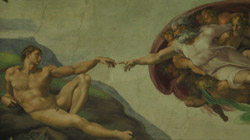The panel of The Creation of Adam in the Sistine Chapel must be one of the most known Michelangelo paintings in the world.
The Iconic Creation of Adam
Completed by Michelangelo circa 1511, it depicts God the Father creating Adam, the first man, and was amongst the last panels to be completed, telling the story of Genesis.
The focal point of the episode of the Creation of Adam painting is the contact between the fingers of God and those of Adam, through which the breath of life is transmitted. By not painting the fingers of God and Adam touching and leaving a small space between the two, Michelangelo creates a tingling tension, an anticipation of that wonderous moment, as we all wait for God to complete his Creation of Adam.
Influence Of Other Artists
Michelangelo’s languid Adam was probably inspired by another artist, Ghiberti’s Adam, in his Doors of Paradise of the Baptistery in Florence.
Whereas in his, The Creation of Eve, Michelangelo borrows heavily from Jacopo della Quercia’s version on the portal of San Petronio in Bologna.
Addressing Artistic Challenges
In the Eve panel Michelangelo did not use foreshortening, making the figures difficult to see clearly from the floor of the chapel. In The Creation of Adam, the great artist addresses this problem with an obvious focus on the enlarged figures of God and Adam.
Rapid Creation and Lasting Impact
The painting of Michelangelo’s Creation of Adam only took two to three weeks to complete, while the actual painting of Adam took Michelangelo only four days.
An admiring Vasari (1511 – 1574) gasped with amazement and said, “A figure of such a kind in its beauty, in the attitude and in the outlines, that it appears as if newly fashioned by the first and supreme Creator rather than by the brush and design of mortal man.” Today we see the Creation of Adam as a masterpiece within a masterpiece.

Michelangelo’s ‘Creation of Adam’, Sistine Chapel ceiling in Vatican Museums.